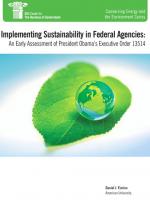
Implementing Sustainability in Federal Agencies: An Early Assessment of President Obama’s Executive Order 13415

 With the issuance of Executive Order 13514 (the EO) on federal sustainability, the Obama administration has called upon the federal government to lead by example: making its operations more sustainable, responsible, and efficient. “As the largest consumer of energy in the U.S. economy, the federal government
With the issuance of Executive Order 13514 (the EO) on federal sustainability, the Obama administration has called upon the federal government to lead by example: making its operations more sustainable, responsible, and efficient. “As the largest consumer of energy in the U.S. economy, the federal government
can and should lead by example when it comes to creating innovative ways to reduce greenhouse gas emissions, increase energy efficiency, conserve water, reduce waste, and use environmentally responsible products and technologies,” said President Obama. This EO should be seen, in broad perspective, as an attempt to make operational the concept of sustainability. By pushing the integration of environmental, energy, and transportation indicators, the EO combines into one strategy the core elements of environmental sustainability.
The IBM Center for The Business of Government just published, Implementing Sustainability in Federal Agencies: An Early Assessment of President Obama’s Executive Order 13415, by Daniel J. Fiorino, American University. The purpose of this report is to describe the initial process for implementing Executive Order 13514.
It aims to achieve three objectives:
- Examine the EO as a strategy for promoting sustainability in federal agencies
- Assess its early implementation—its strengths, weaknesses, and areas for improvement
- Offer recommendations for the next phases of implementing the EO
The report is prepared in the second year of Executive Order 13514’s implementation. Given the 10-year timeframe of targets and goals, this is an early assessment of the order and its implementation strategy. The first year (2010) was one of planning, collecting data, and creating the organizational and information infrastructure needed for implementation. The primary planning tool required by the EO, the Strategic Sustainability Performance Plan, was due from agencies to the Office of Management and Budget (OMB) and Council on Environmental Quality (CEQ) in June 2010. During the following months, OMB and CEQ assessed the documents and provided feedback and guidance. During the second year of the EO (2011), agencies have shifted from planning to implementation. The final year for implementation of the EO, based on the target dates for all the goals, is 2020. Agencies are thus just at the start of the entire process. 
Therefore, we offer this report as an implementation or process analysis, not a program evaluation. The former concerns the way in which a particular policy or program is implemented. An evaluation, in contrast, is concerned with the effects of a program or policy given the outcomes it is intended to achieve. It is far too early for an evaluation of EO 13415; there are few outcomes to assess. An implementation analysis, on the other hand, may be helpful at this point in time. Our goal is that this report will provide the groundwork for more comprehensive evaluations later in the EO’s implementation process. The concept of sustainability is a unifying principle of Executive Order 13514 and it represents a significant effort to articulate the concept of sustainability and incorporate it into national policy.
This report by Dan Fiorino complements one recent IBM report, Breaking New Ground: Promoting Environmental and Energy Programs in Local Government, Svara, Read, and Moulder, which focus on local government efforts around pursuing sustainability programs. Taken together, our readers are provided well-rounded insights into how governments at the federal, state, and local levels are taken action today in the hopes of securing a better, more sustainable future.
Other Center Resources
Business of Government Hour Interview with Michelle Moore, Federal Environmental Executive
A Conversation with Sam Pulcrano, Vice President of Sustainability, U.S. Postal Service
Business of Government Hour Interview with Sam Pulcrano , VP Sustainability, USPS



